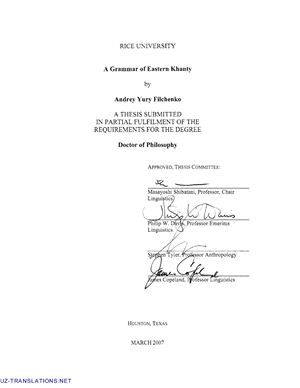Filchenko A. Y. A Grammar of Easte Khanty. - Houston: Rice
University, 2007. - 615 p.
A reference grammar of the endangered indigenous Easte Khanty dialects of Vasyugan and Alexandrovo of the Uralic language family has been developed. The study bases on the corpus of natural narrative discourse, and is set in a general cognitive-functional, usage-based model of language. The description addresses the main pattems of the Easte Khanty language system and offers some typological contextualization of the reviewed language data. The description covers the issues in phonology, word-classes, morphology, syntax and semantics of simple and complex clauses. In the area of phonology, such systematic features as robust backness vowel harmony and consonant-vowel harmony are analyzed in the articulatory gesture framework. Morphologically, the system is agglutinating with suffixation dominant in derivation and inflection. Syntactically, Easte Khanty pattems as a typical SOV language. Occasional non-prototypical features include non-canonical argument marking along ergative patte against the general background of Nom-Acc system of GR organization. In mapping of the pragmatic functions - to semantic roles - to grammatical relations, Easte Khanty shows strong preference towards Topic-initiality, typically mapped onto Agent semantic role. This preference remains dominant in detransitivisation operations, where the prototypical mapping is altered towards Topic-Target-S that generally has to do with the parenthetical demotion of pragmatic status of the Agent referent and promotion of the non-Agent. Analysis of Easte Khanty complex clauses reveals robust use of finite and non-finite (participial, infinitival and converbial) constructions as relative, adverbial and
complement clauses in typologically common strategies of clause-linking. Traditional discrete differentiation into subordinate and coordinate types based on morphosyntactic criteria appears inadequate, divorced from the structural diversity of the observed complex clauses. Cognitive-functional approach is used instead, implying a universal way of construal of linked events, appealing to cognitive relations between states-of-affairs, rather than particular structural means. This results in a continuum of combinable features locating each clause in relation to either the subordinate or coordinate prototypes. Clause-linkage strategies are related to the pragmatic differentiation of information in utterances, with pragmatics, information structuring aspects being at the core of the distinction between the subordination and coordination.
A reference grammar of the endangered indigenous Easte Khanty dialects of Vasyugan and Alexandrovo of the Uralic language family has been developed. The study bases on the corpus of natural narrative discourse, and is set in a general cognitive-functional, usage-based model of language. The description addresses the main pattems of the Easte Khanty language system and offers some typological contextualization of the reviewed language data. The description covers the issues in phonology, word-classes, morphology, syntax and semantics of simple and complex clauses. In the area of phonology, such systematic features as robust backness vowel harmony and consonant-vowel harmony are analyzed in the articulatory gesture framework. Morphologically, the system is agglutinating with suffixation dominant in derivation and inflection. Syntactically, Easte Khanty pattems as a typical SOV language. Occasional non-prototypical features include non-canonical argument marking along ergative patte against the general background of Nom-Acc system of GR organization. In mapping of the pragmatic functions - to semantic roles - to grammatical relations, Easte Khanty shows strong preference towards Topic-initiality, typically mapped onto Agent semantic role. This preference remains dominant in detransitivisation operations, where the prototypical mapping is altered towards Topic-Target-S that generally has to do with the parenthetical demotion of pragmatic status of the Agent referent and promotion of the non-Agent. Analysis of Easte Khanty complex clauses reveals robust use of finite and non-finite (participial, infinitival and converbial) constructions as relative, adverbial and
complement clauses in typologically common strategies of clause-linking. Traditional discrete differentiation into subordinate and coordinate types based on morphosyntactic criteria appears inadequate, divorced from the structural diversity of the observed complex clauses. Cognitive-functional approach is used instead, implying a universal way of construal of linked events, appealing to cognitive relations between states-of-affairs, rather than particular structural means. This results in a continuum of combinable features locating each clause in relation to either the subordinate or coordinate prototypes. Clause-linkage strategies are related to the pragmatic differentiation of information in utterances, with pragmatics, information structuring aspects being at the core of the distinction between the subordination and coordination.

